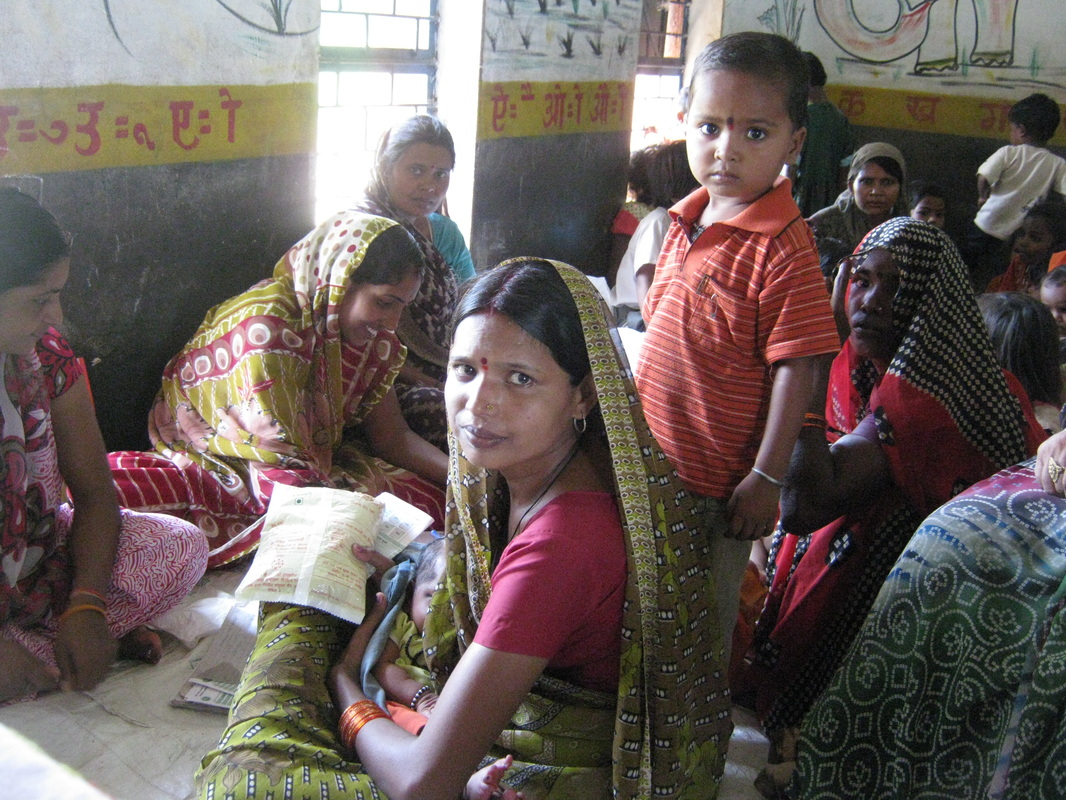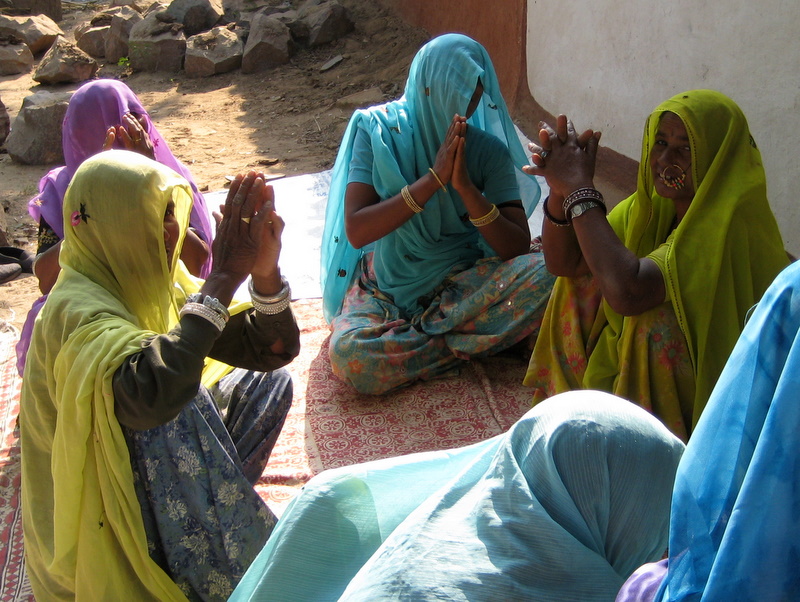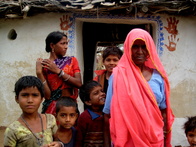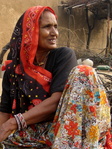Editorial of the month
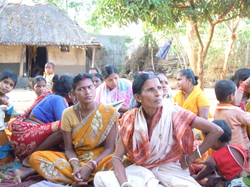
The Dilemma of Family Planning Programmes in India: My visit to a District Headquarter Hospital in Odisha
By Sarita Barpanda
One of the common question asked by the women who were there with the ASHAs (Accredited Social Health Activists) in the Khurda District Headquarter Hospital during my visit on 24 June 2013 was, "are you sterilised?" And my response was ‘No’; the women would look at one another and very understandingly respond, ‘you are trying for a son’. My response was again ‘No’, they were bewildered and asked me how I have managed not to have any more children after giving birth to two daughters who are now in their teen and preteen, and what was my families response about not having a son. I responded that the onus of not to have more children and not to have a son was jointly on me and my husband, my words were met with absolute silence.
In their world giving birth to a son was an absolute necessity and their responsibility; daughters were not somebody who were welcomed into the house; and the onus of not having more children was the responsibility of a woman, This has been quite advantageous and has made the work of the eight ASHAs who were present there that day quite easy. Out of the seven women who were in labour and had been motivated by the ASHAs to come to the hospital for institutional delivery, five of them had decided to opt for postpartum sterilisation as they had already borne the coveted son for their family (for two of them it was their first child). However, amongst them, 24 year old Sunita Mahapatra who had a four year old son, craved for a daughter, but had been strictly warned by her mother-in-law not to expect it and come back again with a son.
During our visit to the hospital, we struggled to make sense of what we had learned about quality of care. Here women lay on the dirty fly infested floor in pain, either waiting to deliver or already delivered trying to keep flies from sitting on their baby, waiting to be discharged further spoke of the inexcusable apathy and injustice these vulnerable women were being subjected to. Some women were lying just in front of the toilet as the number of beds available in the hospital was around 35 and the number of delivery cases that day was around 100. One of the ASHA shared that two clients that she had brought with her had been turned away by the hospital due to lack of beds and they had gone to the only private nursing home in Khurda managed by an Obstetrics and Gynaecology Specialist working in the District Headquarter Hospital. This particular Medical Officer had not turned up that day as he did not want to respond to ‘our uncomfortable questions’, the state family planning unit had informed the staff of the district hospital that people from Delhi would be visiting the hospital. This particular Medical Officer had physically manhandled and pushed out the Reproductive and Child Health (RCH) Counsellor from the hospital as he felt she was not allowing patients to be shifted to his nursing home. The RCH Counselor was forced to sit with the District Programme Management Unit instead of counselling women on contraceptives and services in the district hospital.
It had been tough for ASHAs too and this was shared by the eight ASHAs who were present there. In 2005 when the ASHA scheme was rolled out in the state everybody thought that ASHAs would play an important role like the ANMs and AWWs in the village; and this would ensure working for the government and earning money for their family. Every woman in the village was interested to work as ASHAs and there was a lot of competition to be one. However, the struggle that the ASHAs have to go through in their course of work sometimes made them question their role. As one of the ASHA’s from Bolpur block shared, ’My financial status is worse than the women who come here to deliver, at least she gets money to deliver, the money I receive is peanuts considering the amount of time and energy I put in ensuring that this women receives institutional delivery. To top it I am the punching bag in my village- now villagers command me to do their health work, if the ANM is not regular then I am supposed to respond, if they are not getting their due then I get the scolding, if a woman delivers at night neither the mother or the mother-in-lawn accompany her, they force me to leave everything and accompany the woman whereas they stay at home. The government officials constantly tell us, for everything you are asking for money, will you not do anything good for your village.”
The entire sequence of events in the district headquarter hospital was bizarre and surreal, the absentee Medical Officer who was yet to arrive, the angry anaesthetist who had been on night duty and was yet to be relieved from the hospital (out of seven specialists posts in the district hospital, Khurda had five Gynaecologist and one Anaesthetist), and a naked women in a semi conscious state on the operation theatre table, about to deliver, made it difficult to envisage that motherhood was a happy and beautiful experience for a woman. The Medical Officer (who had been recently transferred to that district) eventually arrived, and was a genial man who had no problems chatting with us; he also did not question as to why there were so many people inside the operation theatre (four people who had nothing to do with the operation, two of them were us and there was a woman relative standing besides the table, the Lady Health Visitor (LHV) and a male assistant) and why there were so many people coming in and out of the operation theatre.
On asking the Medical Officer whether he undertook female sterilisation, he categorically said, ‘no’. The LHV who was standing besides us angrily hissed at the Medical Officer and said, ‘Why can’t you keep quiet’ forgetting for a moment that I could understand and speak Odia. She turned towards us and said, ‘The Medical Officer does not understand many things as he is new, he has done sterilisation and we are deeply involved in increasing sterilisation and reaching targets, come I will show you the register that I keep that will give a picture on the number of sterilisation that we do’. The LHV took us to her room and showed us her register. And as we looked at her register and data of the last six months we realised that she was diligent and had recorded each of her case very carefully. Some of the key things that were starkly evident in her register were:
1. All the women who had undergone tubal ligation in the last four months had come for delivery and once they were through caesarean they had their tubes tied;
2. All the women were below thirty, and the youngest was 21 years old;
3. All the women had either two sons, or one son and a daughter; no cases reflecting two daughters who had sterilisation has been reported since the past six months;
4. There was only one woman who had refused sterilisation and the hospital staff had not tried to motivate her as they understood her predicament. This woman had three daughters and her husband and mother-in-law expected a son from her.
The LHV of the hospital, who was determined to show the hospital as a successful static sterilisation centre, shared that she and her team of three Health Workers motivated all the women who were supposed to undergo caesarean to get their tubes tied right after they delivered. She further went on to say that in the past three months any woman who had come for abortion had been provided with IUCD. One of the challenges cited by the LHV was to manage the ASHAs as many times they were unable to motivate women to opt for sterilisation, and it became her teams’ responsibility to ensure that the women filled up the consent form before they went into the operation theatre. Men rarely opted for male sterilisation and the registers showed only one male sterilisation case since the past six months.
The Khurda District Headquarter Hospital is seen as one of the functional family planning centres in the state. The term family planning in Odisha was misleading as the only service that this hospital was providing was female sterilisation and recently IUCD. As targets were set by the District Headquarter Hospital, the LHV and the Health Workers took it as their moral responsibility to ensure that these targets were reached, as this was seriously questioned by the CDMO as well as the state health official if they failed to do so.
What makes it all the more worse is the fact that at the community level the ASHAs are supposed to be the flag bearers of the sterilisation programme and their achievement depends on the number of clients they can bring to the static clinics or to the camps, and the Medical Officer’s success depends on the number of sterilisation procedures undertaken. World Population fortnight is celebrated with a lot of pomp and glory and the Chief Minister duly recognises the ANM, Medical Officer and ASHA who have undertaken the maximum sterilisation and felicitates them as well as the districts which have the highest percentage of sterilisations undertaken.
One of the ASHA’s statement aptly sums up the current scenario,’ I get Rs. 1,000/- +Rs.120/- when I do a female sterilisation, whereas if I promote any other contraceptive method I do not get much incentives, if I get four sterilisation cases in a month it takes care of my family. So I would definitely promote female sterilisation.
A state where women’s reproductive right violation by promoting only female sterilisation as a way of birth control is publicly promoted, tells a grim picture of the state of the girl child. Female sterilisation seems an extreme form of contraception for women in the reproductive age. Targets (Expected Level of Achievement as government at the state and the centre define it currently) have affected women and worsened the process; and there is a need to rethink and reevaluate our population policies and see whether rights and dignity are core principles of these.
(Sarita Barpanda is a Programme Director of Centre for Health and Social Justice, Saket, Delhi)
By Sarita Barpanda
One of the common question asked by the women who were there with the ASHAs (Accredited Social Health Activists) in the Khurda District Headquarter Hospital during my visit on 24 June 2013 was, "are you sterilised?" And my response was ‘No’; the women would look at one another and very understandingly respond, ‘you are trying for a son’. My response was again ‘No’, they were bewildered and asked me how I have managed not to have any more children after giving birth to two daughters who are now in their teen and preteen, and what was my families response about not having a son. I responded that the onus of not to have more children and not to have a son was jointly on me and my husband, my words were met with absolute silence.
In their world giving birth to a son was an absolute necessity and their responsibility; daughters were not somebody who were welcomed into the house; and the onus of not having more children was the responsibility of a woman, This has been quite advantageous and has made the work of the eight ASHAs who were present there that day quite easy. Out of the seven women who were in labour and had been motivated by the ASHAs to come to the hospital for institutional delivery, five of them had decided to opt for postpartum sterilisation as they had already borne the coveted son for their family (for two of them it was their first child). However, amongst them, 24 year old Sunita Mahapatra who had a four year old son, craved for a daughter, but had been strictly warned by her mother-in-law not to expect it and come back again with a son.
During our visit to the hospital, we struggled to make sense of what we had learned about quality of care. Here women lay on the dirty fly infested floor in pain, either waiting to deliver or already delivered trying to keep flies from sitting on their baby, waiting to be discharged further spoke of the inexcusable apathy and injustice these vulnerable women were being subjected to. Some women were lying just in front of the toilet as the number of beds available in the hospital was around 35 and the number of delivery cases that day was around 100. One of the ASHA shared that two clients that she had brought with her had been turned away by the hospital due to lack of beds and they had gone to the only private nursing home in Khurda managed by an Obstetrics and Gynaecology Specialist working in the District Headquarter Hospital. This particular Medical Officer had not turned up that day as he did not want to respond to ‘our uncomfortable questions’, the state family planning unit had informed the staff of the district hospital that people from Delhi would be visiting the hospital. This particular Medical Officer had physically manhandled and pushed out the Reproductive and Child Health (RCH) Counsellor from the hospital as he felt she was not allowing patients to be shifted to his nursing home. The RCH Counselor was forced to sit with the District Programme Management Unit instead of counselling women on contraceptives and services in the district hospital.
It had been tough for ASHAs too and this was shared by the eight ASHAs who were present there. In 2005 when the ASHA scheme was rolled out in the state everybody thought that ASHAs would play an important role like the ANMs and AWWs in the village; and this would ensure working for the government and earning money for their family. Every woman in the village was interested to work as ASHAs and there was a lot of competition to be one. However, the struggle that the ASHAs have to go through in their course of work sometimes made them question their role. As one of the ASHA’s from Bolpur block shared, ’My financial status is worse than the women who come here to deliver, at least she gets money to deliver, the money I receive is peanuts considering the amount of time and energy I put in ensuring that this women receives institutional delivery. To top it I am the punching bag in my village- now villagers command me to do their health work, if the ANM is not regular then I am supposed to respond, if they are not getting their due then I get the scolding, if a woman delivers at night neither the mother or the mother-in-lawn accompany her, they force me to leave everything and accompany the woman whereas they stay at home. The government officials constantly tell us, for everything you are asking for money, will you not do anything good for your village.”
The entire sequence of events in the district headquarter hospital was bizarre and surreal, the absentee Medical Officer who was yet to arrive, the angry anaesthetist who had been on night duty and was yet to be relieved from the hospital (out of seven specialists posts in the district hospital, Khurda had five Gynaecologist and one Anaesthetist), and a naked women in a semi conscious state on the operation theatre table, about to deliver, made it difficult to envisage that motherhood was a happy and beautiful experience for a woman. The Medical Officer (who had been recently transferred to that district) eventually arrived, and was a genial man who had no problems chatting with us; he also did not question as to why there were so many people inside the operation theatre (four people who had nothing to do with the operation, two of them were us and there was a woman relative standing besides the table, the Lady Health Visitor (LHV) and a male assistant) and why there were so many people coming in and out of the operation theatre.
On asking the Medical Officer whether he undertook female sterilisation, he categorically said, ‘no’. The LHV who was standing besides us angrily hissed at the Medical Officer and said, ‘Why can’t you keep quiet’ forgetting for a moment that I could understand and speak Odia. She turned towards us and said, ‘The Medical Officer does not understand many things as he is new, he has done sterilisation and we are deeply involved in increasing sterilisation and reaching targets, come I will show you the register that I keep that will give a picture on the number of sterilisation that we do’. The LHV took us to her room and showed us her register. And as we looked at her register and data of the last six months we realised that she was diligent and had recorded each of her case very carefully. Some of the key things that were starkly evident in her register were:
1. All the women who had undergone tubal ligation in the last four months had come for delivery and once they were through caesarean they had their tubes tied;
2. All the women were below thirty, and the youngest was 21 years old;
3. All the women had either two sons, or one son and a daughter; no cases reflecting two daughters who had sterilisation has been reported since the past six months;
4. There was only one woman who had refused sterilisation and the hospital staff had not tried to motivate her as they understood her predicament. This woman had three daughters and her husband and mother-in-law expected a son from her.
The LHV of the hospital, who was determined to show the hospital as a successful static sterilisation centre, shared that she and her team of three Health Workers motivated all the women who were supposed to undergo caesarean to get their tubes tied right after they delivered. She further went on to say that in the past three months any woman who had come for abortion had been provided with IUCD. One of the challenges cited by the LHV was to manage the ASHAs as many times they were unable to motivate women to opt for sterilisation, and it became her teams’ responsibility to ensure that the women filled up the consent form before they went into the operation theatre. Men rarely opted for male sterilisation and the registers showed only one male sterilisation case since the past six months.
The Khurda District Headquarter Hospital is seen as one of the functional family planning centres in the state. The term family planning in Odisha was misleading as the only service that this hospital was providing was female sterilisation and recently IUCD. As targets were set by the District Headquarter Hospital, the LHV and the Health Workers took it as their moral responsibility to ensure that these targets were reached, as this was seriously questioned by the CDMO as well as the state health official if they failed to do so.
What makes it all the more worse is the fact that at the community level the ASHAs are supposed to be the flag bearers of the sterilisation programme and their achievement depends on the number of clients they can bring to the static clinics or to the camps, and the Medical Officer’s success depends on the number of sterilisation procedures undertaken. World Population fortnight is celebrated with a lot of pomp and glory and the Chief Minister duly recognises the ANM, Medical Officer and ASHA who have undertaken the maximum sterilisation and felicitates them as well as the districts which have the highest percentage of sterilisations undertaken.
One of the ASHA’s statement aptly sums up the current scenario,’ I get Rs. 1,000/- +Rs.120/- when I do a female sterilisation, whereas if I promote any other contraceptive method I do not get much incentives, if I get four sterilisation cases in a month it takes care of my family. So I would definitely promote female sterilisation.
A state where women’s reproductive right violation by promoting only female sterilisation as a way of birth control is publicly promoted, tells a grim picture of the state of the girl child. Female sterilisation seems an extreme form of contraception for women in the reproductive age. Targets (Expected Level of Achievement as government at the state and the centre define it currently) have affected women and worsened the process; and there is a need to rethink and reevaluate our population policies and see whether rights and dignity are core principles of these.
(Sarita Barpanda is a Programme Director of Centre for Health and Social Justice, Saket, Delhi)
